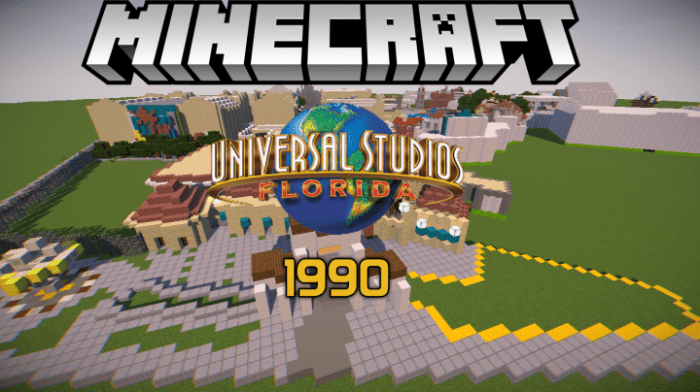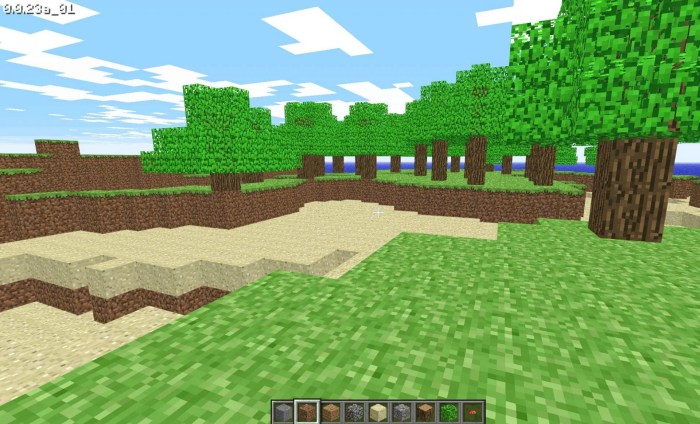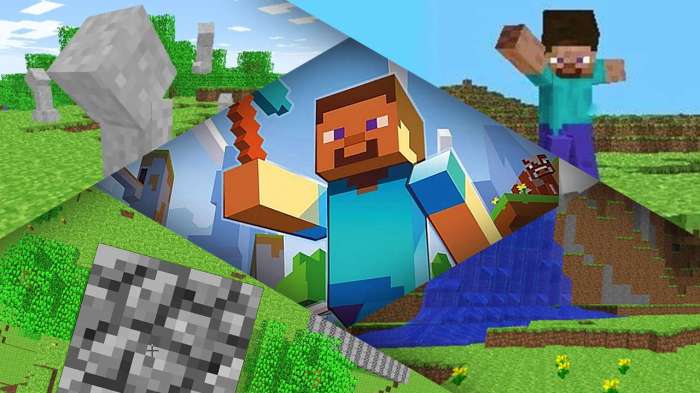A Look Back at Minecraft 3D 1990: The Early Evolution takes us on a nostalgic journey to the genesis of a gaming phenomenon. The story begins in the 1990s, long before the blocky world we know and love became a global sensation.
It’s a tale of humble beginnings, technical hurdles, and the unwavering vision of a few passionate developers. Imagine a time when the internet was still in its infancy, and the concept of a 3D world built entirely from blocks was a revolutionary idea.
The early development of Minecraft was a fascinating blend of technical limitations and creative ingenuity. The developers, working with limited resources and primitive tools, crafted a rudimentary version of the game that laid the foundation for its future success. They experimented with different gameplay mechanics, wrestled with the challenges of 3D graphics, and meticulously shaped the world’s block-based construction system.
This period was crucial in defining the core elements that would become synonymous with Minecraft, from the thrill of exploration to the satisfaction of building elaborate structures.
The Genesis of Minecraft
The origins of Minecraft can be traced back to the early 1990s, long before the game’s official release in 2011. The initial concept, then known as “Minecraft 3D,” emerged from a blend of inspiration drawn from classic games and the burgeoning world of 3D graphics.
This early iteration of Minecraft was a far cry from the polished, open-world experience we know today. It was a rudimentary prototype, developed in the pre-internet era, and its creation was driven by a desire to explore the potential of 3D environments and the nascent possibilities of computer-generated worlds.
Early Development Environment
The early development of “Minecraft 3D” took place within the constraints of limited computing power and rudimentary software tools. The primary development environment was a combination of:
- Programming Languages:The early developers relied heavily on programming languages like C++ and assembly language, which were commonly used for game development during that era. These languages offered greater control over hardware and system resources, but they were also complex and demanding to master.
- Graphics Engines:The development of 3D graphics was still in its infancy, and the available graphics engines were primitive by today’s standards. These engines often required significant manual optimization and lacked the sophisticated features found in modern game development tools.
- Hardware:Early personal computers were significantly less powerful than their modern counterparts. Limited processing power, memory, and graphics capabilities presented significant challenges for creating complex 3D environments.
Technical Limitations and Challenges
The early developers faced a myriad of technical limitations and challenges:
- Performance:Rendering 3D environments with the limited processing power available at the time was a significant bottleneck. The developers had to carefully optimize their code and simplify the game’s visuals to achieve acceptable frame rates.
- Memory Management:The limited memory capacity of early computers made it difficult to store large amounts of data, such as textures and models. Developers had to be resourceful in their use of memory and employ techniques like texture compression to minimize resource consumption.
From the pixelated landscapes of Minecraft 3D 1990 to the intricate worlds of today, the game has evolved tremendously. While the early versions were more about exploration and resource gathering, the latest iterations like Minecraft 1.19 have added incredible depth with features like the Warden, the Deep Dark, and even Mangrove Swamps.
To learn more about these new additions, check out Exploring Minecraft 1.19 3D: What’s New? and see how far Minecraft has come since its humble beginnings.
- Graphics Capabilities:The early graphics engines were limited in their ability to render complex geometry and special effects. The developers had to be creative in using simple shapes and textures to create visually compelling environments.
- Development Tools:The lack of sophisticated development tools and libraries made the development process more laborious and error-prone. Developers had to write much of their code from scratch, and there were limited resources available to help them debug and optimize their games.
From 2D to 3D

The early iterations of “Minecraft 3D” were primarily 2D, showcasing a top-down perspective with blocky graphics. This initial phase laid the groundwork for the game’s core mechanics, but it wasn’t until the transition to 3D that “Minecraft” truly began to take shape.
The shift from 2D to 3D dramatically altered the gameplay experience, introducing new possibilities for exploration, building, and resource gathering.
Transition to 3D, A Look Back at Minecraft 3D 1990: The Early Evolution
The transition from 2D to 3D in “Minecraft” was a significant step in the game’s evolution. It allowed for a more immersive and engaging experience, providing players with a greater sense of depth and scale within the game world. The 3D perspective enabled players to freely explore their surroundings, navigate intricate structures, and interact with the environment in a more realistic way.
The introduction of a first-person perspective further enhanced the player’s immersion, allowing them to feel like they were truly present in the game world. This shift also impacted the game’s design, as developers had to adapt the game’s mechanics and features to accommodate the new 3D environment.
Evolution of Exploration, Building, and Resource Gathering
The transition to 3D had a profound impact on how players explored, built, and gathered resources in “Minecraft.” The ability to move freely in a 3D environment allowed for more intricate and complex exploration, with players able to discover hidden caves, climb mountains, and traverse vast landscapes.
The 3D perspective also enabled players to create more elaborate and detailed structures, with the ability to build vertically and horizontally, creating structures that were previously impossible in the 2D version. Resource gathering was also enhanced, as players could now mine resources from different angles and heights, making the process more efficient and engaging.
Shaping the World

The Minecraft of 1990, though rudimentary, laid the foundation for the iconic block-based construction system that defines the game today. The core concept of manipulating cubic blocks to build structures was already present, setting the stage for the game’s creative potential.
The Block-Based Construction System
The block-based construction system in Minecraft 3D 1990 was a simple yet powerful concept. Players could interact with the environment by placing and removing blocks, creating structures and landscapes. The game’s limited graphics and mechanics made it clear that the focus was on the player’s creativity and ability to shape the world.
This emphasis on creative freedom would become a defining characteristic of Minecraft, allowing players to build anything imaginable within the game’s virtual world.
Block Types and Properties
The initial block types in Minecraft 3D 1990 were limited but reflected the basic elements of the game’s world. These included:
- Grass: Represented the ground and natural terrain.
- Dirt: Another common ground material, often found beneath grass.
- Stone: A durable building material, typically found in caves or underground.
- Wood: Used for constructing simple structures and crafting tools.
Each block had specific properties that determined its appearance and how it interacted with other blocks. For example, grass blocks could be placed on dirt, while stone blocks could be placed on top of grass or dirt. This simple system allowed players to build structures and create landscapes with basic materials.
Early Structures and Creations
While the game’s early development lacked advanced features, players still found ways to express their creativity through the limited block system. Examples of early creations included:
- Simple Houses: Players used blocks to create basic shelters with walls, floors, and roofs.
- Tower Structures: Players experimented with building tall towers, showcasing the game’s verticality.
- Basic Landscapes: Players utilized the different block types to create simple landscapes with hills and valleys.
These early creations, though basic, demonstrated the potential of the block-based construction system. They paved the way for the complex and intricate structures that would become a hallmark of Minecraft in later versions.
The Rise of the Community: A Look Back At Minecraft 3D 1990: The Early Evolution
The early days of Minecraft saw a gradual but steady growth of a passionate community. Players, drawn to the game’s unique blend of creativity and exploration, started to connect, share their experiences, and contribute to the game’s evolution. The early community played a pivotal role in shaping Minecraft’s identity and fostering its widespread popularity.
The Impact of Early Players
The early players of Minecraft were instrumental in shaping the game’s development and fostering its unique community. They actively engaged in the game, exploring its possibilities, sharing their creations, and providing valuable feedback to the developers. This early feedback helped Notch refine the game’s mechanics and introduce new features, directly influencing the game’s direction.
“The community was really important for the development of Minecraft,” said Notch in an interview. “They were constantly giving me feedback and suggestions, and I was always listening to them.”
- Early Explorers:Players like Jeb, Dinnerbone, and Grumm were among the first to delve deep into the game’s mechanics, discovering hidden features, crafting innovative builds, and sharing their discoveries with the community. Their contributions helped create a sense of shared exploration and discovery within the game.
- Community Builders:Players like CaptainSparklez, SethBling, and TheSyndicateProject emerged as prominent figures within the community, creating content that showcased the game’s potential and attracted a wider audience. Their videos, tutorials, and Let’s Plays helped introduce Minecraft to a new generation of players and fostered a sense of community among them.
From Prototype to Phenomenon
The journey from the initial prototypes of Minecraft 3D 1990 to its eventual release as a fully-fledged game was a testament to the vision and dedication of its creator, Markus “Notch” Persson. This period saw the game evolve from a simple, experimental concept to a complex, multifaceted world that would capture the imaginations of millions.
The Evolution of Gameplay
The development of Minecraft 3D 1990 into a full-fledged game involved a series of incremental changes, each refining the core gameplay mechanics and adding new features.
- Early versions focused on simple exploration and resource gathering, with players able to break blocks and build structures.
- Later versions introduced crafting, allowing players to combine materials to create new tools and weapons.
- The addition of mobs, or in-game creatures, introduced a layer of challenge and complexity to the game, requiring players to strategize and defend themselves.
- The inclusion of a day-night cycle and weather effects further enriched the game world, adding a sense of realism and depth to the gameplay experience.
Marketing and Distribution
The unique concept of Minecraft presented a challenge for marketing and distribution.
- Unlike traditional games with clear genres and target audiences, Minecraft’s open-ended gameplay and pixelated graphics were initially perceived as unconventional.
- The early versions of the game were primarily distributed through independent gaming websites and forums, relying heavily on word-of-mouth and community buzz.
- The use of early access platforms, such as Indiegogo and later, Minecraft’s own website, allowed players to access the game early and provide feedback, further fueling its growth and development.
Factors Contributing to Success
The success of Minecraft can be attributed to a combination of factors.
- The game’s open-ended nature, allowing players to create and explore freely, resonated with a wide audience, attracting both casual and hardcore gamers.
- The game’s simplicity and accessibility made it easy to learn and enjoy, attracting players of all ages and skill levels.
- The game’s focus on creativity and community fostered a vibrant online community, with players sharing their creations, collaborating on projects, and even organizing competitions.
- The game’s constant evolution and updates kept players engaged and excited, ensuring a steady stream of new content and features.
Wrap-Up

The early evolution of Minecraft, from its 1990s origins to the release of the first prototype, is a testament to the power of creativity and perseverance. It’s a reminder that even the most iconic games have humble beginnings and that the journey from concept to phenomenon is often paved with challenges and breakthroughs.
The story of Minecraft’s early development is a fascinating glimpse into the minds of its creators, their struggles, and their triumphs. It’s a journey that reveals the origins of a game that would captivate millions worldwide, transforming the gaming landscape forever.